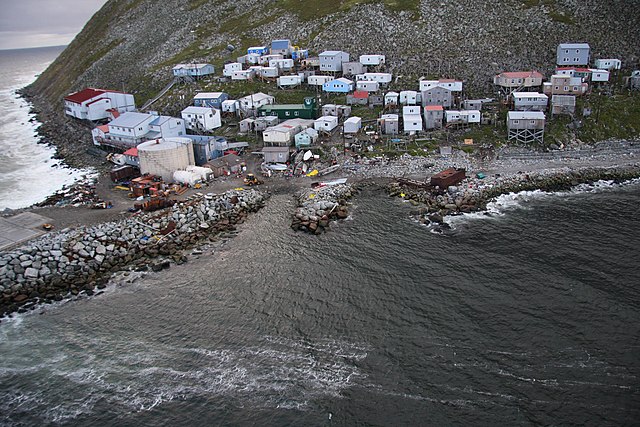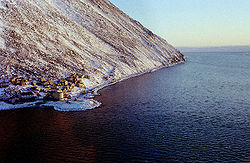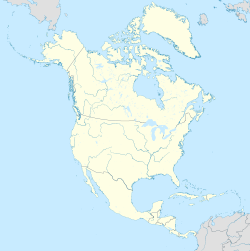Top Qs
Timeline
Chat
Perspective
Diomede, Alaska
City in northwest Alaska From Wikipedia, the free encyclopedia
Remove ads
Diomede (Inupiaq: Iŋaliq, Russian: Диомид, romanized: Diomid) is an incorporated city on the west coast of Little Diomede Island[4] in the U.S. state of Alaska. Little Diomede Island is the smaller of the two Diomede Islands that are located in the middle of the Bering Strait; the larger of the two islands, Big Diomede Island, is part of Russia.[5] As of 2020, the population of Diomede is 82.[6]

Diomede's native name, Iŋaliq, means "the other one" or "the one over there".[7]
Remove ads
History
Summarize
Perspective
The current location of the city is believed by some archaeologists to have been inhabited for at least 3,000 years.[4] It was originally a spring hunting campsite and the early explorers from the west found the Iñupiat (Inuit) at Diomede had an advanced culture, including elaborate whale hunting ceremonies.[8] Trade occurred with both continents.[9]
1648–1867
The first European to reach the Diomede Islands was Russian explorer Semyon Dezhnev, in 1648; the next was Danish-born Russian navigator and explorer Vitus Bering, who re-discovered the islands on August 16, 1728, and named the islands after martyr St. Diomede, who was celebrated in the Russian Orthodox Church on that date.[10]
The United States purchased Alaska from Russia in 1867, including Little Diomede. A new boundary was drawn between the two Diomede Islands, and the Big Diomede was left to Russia.[11]
1880s–1920s
In the town's census of 1880, 40 residents of the island were recorded.[12] According to naturalist John Muir, who visited the Diomede Islands in the 1880s, natives were eager to trade away everything they had. The village was perched on the steep rocky slope of the mountain, which has sheer drops into deep water. Huts were mostly built of stone with skin roofs.[13]
During the Nome gold rush at the turn of the 20th century, Diomede villagers traveled to Nome along with the gold seekers, even though Nome was not a native village. People from Diomede arrived in umiaks and stayed in Nome for the summer, trading and gathering items before they returned to their isolated village.[14]
1930s-1940s
The first square building on the island was a small Catholic church, which was planned by Father Bellarmine Lafortune in 1935 and built by Father Thomas Cunningham during his residency on the island between 1936 and 1947. It was built from donated lumber from Nome.[15]
According to Arthur Ahkinga, who lived on Little Diomede island at the turn of the 1940s, the Iñupiat on the island made their living by hunting and carving ivory that they traded or sold. They caught fish such as bullheads, tomcods and blue cods. Whaling was still a major practice.[16] During the winter, they used fur parkas and skin mukluks made out of hunted animals to protect themselves from the cold and wind. Recreational activities included skating, snowshoeing, handball, soccer and Inuit dancing. After dark, people spent the rest of the evening telling jokes and stories. In summer time, they traveled with skin boats equipped with outboard motors to Siberia or Wales, Alaska. Winter travel was limited to neighboring Big Diomede due to weather conditions. Between July and October, half of the population went to Nome to sell their carvings and skins and trade for supplies.[17]
Despite being separated by the new border after the Alaska Purchase in 1867, Big Diomede had been home to families now living on Little Diomede, and the people living on the American side of the border were close relatives to those living on the Russian side. The communities on both islands were separated by politics but connected by family kinships. Despite being officially forbidden, the Inuit from both islands occasionally visited their neighbors, sometimes under the cover of fog, to meet their relatives and exchange small gifts. The local schoolteachers on Little Diomede counted 178 people from Big Diomede and the Siberian mainland who visited the island within six months, between January and July in 1944.[4]
At the beginning of the Cold War in the late 1940s, Big Diomede became a USSR (Soviet Union) military base, and all its native residents were removed to mainland Russia.[4] When people from Little Diomede went too close to the Russian side or tried to visit their relatives on the neighboring island during World War II, they were arrested. According to one of the survivors, Oscar Ahkinga, after 52 days of internment and interrogation, the Iñupiat were banished and told not to come back.[18]
1950s
The school year 1953–1954 on Little Diomede Island was adapted to better serve the local needs. Teaching took place throughout the holidays and also on some weekends in order to complete the 180 days of schooling before the walrus migration started in Spring. The annual walrus hunt was a major source of supplies and income and required the help of all inhabitants. The primary language at the time was Inupiat, and students were also taught English. The only means of communicating with the outside world was by so-called "Bush Phone," provided through the Alaska Communication System station in Nome.[19] Previously non-existent health care was improved with basic medication knowledge provided by seasonal teachers.[4]
1970s
During the seventies, the village on Little Diomede was gradually inhabited as a permanent settlement and the entire island was incorporated into the city of Diomede in 1970.[20][21]
A new, larger church building built by Father Thomas Carlin and Brother Ignatius Jakes was completed on March 3, 1979.[15][16]
1980s
On August 7, 1987, American swimmer Lynne Cox swam between American Little Diomede Island and then Soviet Big Diomede Island. Cox performed the swim as a peace gesture, hoping to help improve American-Soviet relations during the final years of the Cold War. Later that year the Soviet Secretary General Gorbachev travelled to Washington to sign a nuclear weapons treaty with American President Reagan. After the signing ceremony Gorbachev raised his glass and proposed a toast to Lynne Cox, the swimmer. He said, "She proved by her courage how close to each other our peoples live."[22]
1990s
Little Diomede, though a whaling community prior to this, was not included in the formation of the Alaska Eskimo Whaling Commission and its needs were not taken into account in determining the bowhead quota for Inupiat and Yupik because of its remote location. In 1992, Little Diomede was formally recognized as a whaling community, per the AEWC.[23]
After the Cold War ended in December 1991, interest in reuniting with families across the Bering Strait grew. In 1994, the people of Little Diomede island collected cash and groceries while local dancers practiced almost every night as the islanders prepared for a visit of more than one hundred friends and relatives from Siberia for which they wanted to be hospitable and generous hosts.[4]
Remove ads
Demographics
Summarize
Perspective
Diomede first appeared on the 1880 U.S. Census as the unincorporated Inuit village of Inalit. It returned as "Ignaluk" on the 1890 census.[25] It next appeared on the 1910-40 censuses as "Little Diomede Island." In 1950, it returned as Diomede. It was incorporated as a city in 1970.[26] Diomede also appears on the census as Inalik, designated as an Alaska Native Village Statistical Area (ANVSA).[citation needed]
2020 census
2000 census
As of the census of 2000, there were 146 people, 43 households, and 31 families residing in the city.[29]
Remove ads
Community
Summarize
Perspective

Electricity
An electric system was built on the island in the 1970s,[4] and electricity is provided by city-operated Diomede Joint Utilities. They provide houses and other facilities with electricity produced by diesel generators. Diesel fuel is stored in large tanks, which are placed at the furthest possible location from the housing. While the electric facility owns the largest fuel tank, measuring 80,000 U.S. gallons (303 m3), the school and the council store both own tanks measuring about 41,000 U.S. gallons (155 m3) each.[30]
Water and disposal
Water for winter use is drawn from a mountain spring, then treated and stored in 434,000-U.S.-gallon (1,640 m3) storage tanks. Because the permafrost prevents pipelines from being installed underground, residents must manually carry water from the tank.[9][16]
Funds for improving the water system have been requested both by the city and the school. Having a separate tank for the school would decrease the usage of city water and would also serve as a backup water supply for the whole city. Funds have also been requested for improvements to refuse collection and for an incinerator, because the ground conditions on the island limits waste disposal to burning combustibles and disposing of everything else on the ice. Honeybuckets and privies are used, except in the laundromat, clinic, and school, which are served by a septic system.[30]
Education
The island's only school is likely the most isolated school in the United States. The Diomede School has approximately 20 students from grades pre-K through 12 and three teachers. It is part of the Bering Strait School District. The number of teachers fluctuates based on the student population.[citation needed]
Health care and emergency services
There is no hospital located on the island, and emergency services are limited due to the remoteness of the island. A city council-owned clinic operates in the laundromat building, providing basic health care.[citation needed]
While other emergency services are provided by volunteers and a health aide, the fire and rescue service is provided by Diomede Volunteer Fire Department and First Responders.[30] In case of a major health emergency, patients are airlifted to the mainland hospital in Nome, weather permitting.[31] The closest law enforcement are dispatched from the Alaska State Troopers barracks on the mainland in Nome.[citation needed]
Frozen ground and lack of soil on the rocky island prevents digging graves, so rocks are piled on top of the burial sites instead.[32]
On November 7, 2009, it was announced that one inhabitant was infected with H1N1 swine flu.[33]
Remove ads
Economy
Employment
Employment on the island is mostly limited to the city, post office, and school. There have been a few seasonal jobs, such as mining and construction, but recently these have been in decline. The Diomede people are excellent ivory carvers and the city serves as a wholesale agent for the ivory.[34] The inhabitants also hunt whales during spring from openings in the sea ice. Whaling largely ceased from the middle to late 20th century, before resuming again in 1999.[35]
Taxes
The city levies a 3% sales tax,[36] but there are no property taxes on the island.
Remove ads
Transportation
Summarize
Perspective
Historical transportation
When Alaska was still connected to Siberia over 10,000 years ago by the Bering Land Bridge, the Little Diomede was not an island but was a part of Beringia and accessible by foot. However, it is unknown whether humans visited the grounds of the Little Diomede at that time. Most likely, the first visitors came when it had become an island, simply by foot on top of the sea ice. Later, Umiaks were used to visit the neighboring Big Diomede island for whale hunting and fishing, and later, to access mainland Alaska and Siberia. Boats made out of driftwood and whale skin are still used today.[9]
In the early 1940s, one of the Little Diomede residents wrote "No airplane comes to Diomede except for some very special reason, during the winter. The MS North Star brings groceries for the people on the island from Nome. At the same time she unloads freight for the school teachers. The Coast Guard cutter Northland comes in twice during the summer to look after the natives".[17]
Internal transport
There are no roads, highways, railroads, or internal waterways on the island. There are ancient but faint rocky trails heading north and south from the City of Diomede. There are also trails between the buildings. In the fall of 2008, many of the footpaths within the city were replaced by a system of boardwalks and stairs.[37]
External transport
Mail has been delivered to the island by helicopter since 1982 and is currently delivered weekly (up until 2013, mail was delivered by plane more frequently in winter months when the ice runway allowed for more deliveries). The postal contract is one of the oldest in the nation, the only one that uses helicopters for delivering mail, and with a cost of over $300,000 annually, is the most expensive in Alaska.[38]
An annual delivery of goods and supplies is made by barge during the summer, which usually is the only cargo delivered during the year. When the supplies come, all the men rush down and pull them off and carry them up.[37]
Due to its location and weather conditions, transportation to the island is very expensive. Having very few economic development opportunities and a tight budget, the city charges non-business visitors arriving by plane or boat a $50.00 fee.[14]
When U.S. Senator Ted Stevens arrived to the island on October 29, 2002, for an overnight visit, he commented "I did not realize you were this remote". He arrived by a National Guard Blackhawk helicopter, and it was the first time the island was visited by a statewide elected official.[4]
Helicopter
Since 2012, the United States Department of Transportation has subsidized scheduled weekly passenger service via helicopter between Diomede Heliport and Nome Airport.[39][40]
Remove ads
See also
References
External links
Wikiwand - on
Seamless Wikipedia browsing. On steroids.
Remove ads



